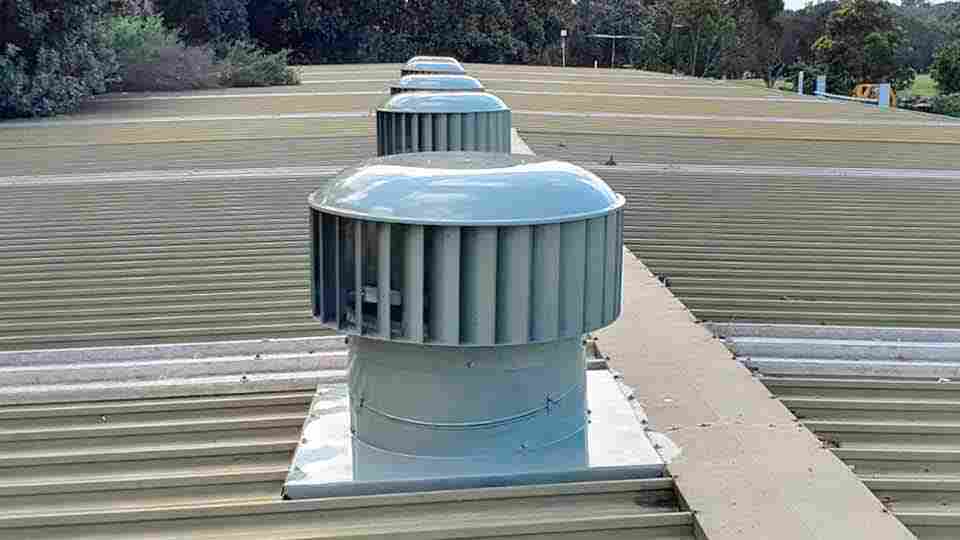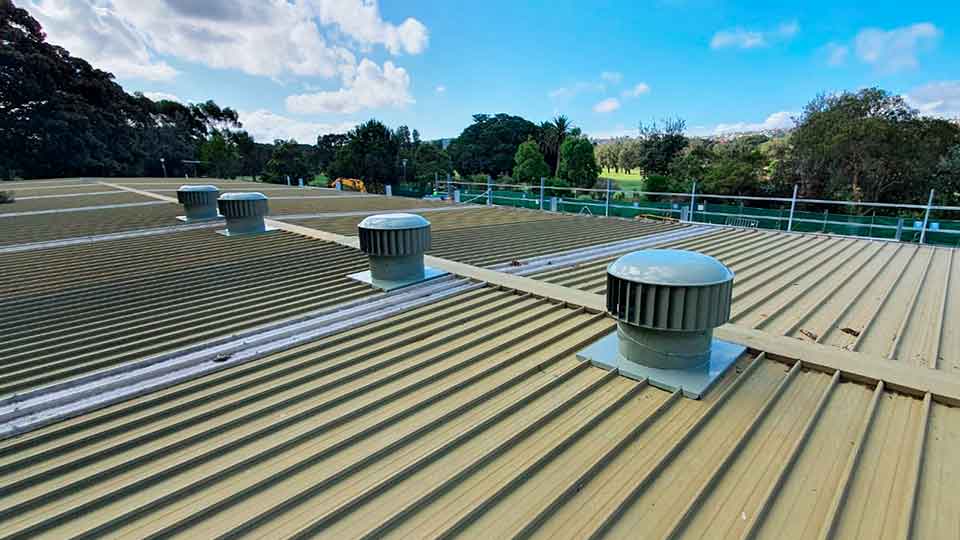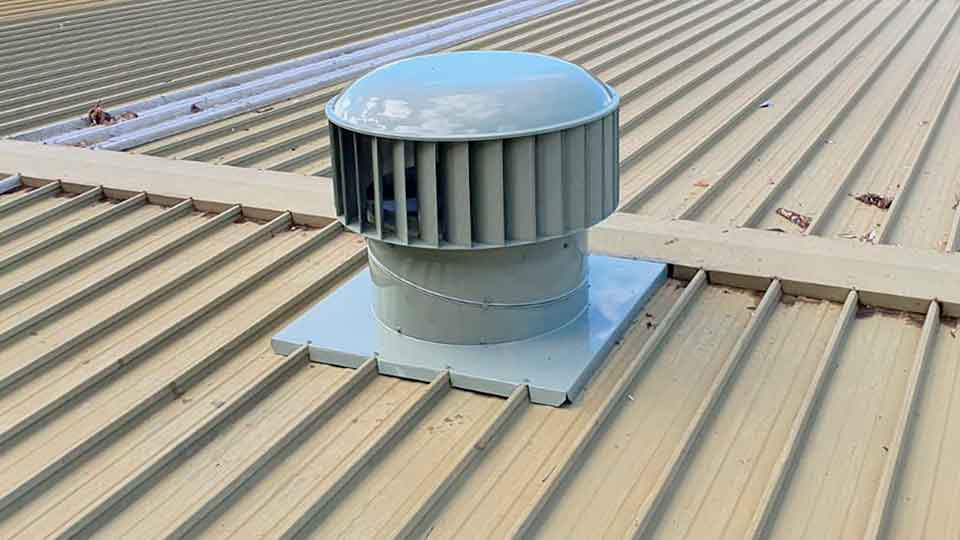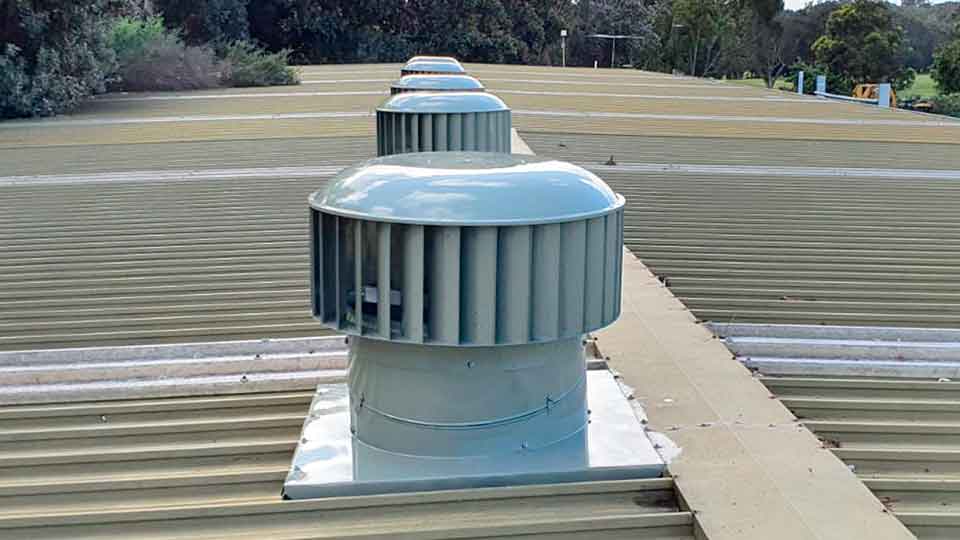Client: Royal Sydney Golf Club
Work Done: Roof Vent & Skylights
contact us today or call direct 1300-564-612
Pan Civil | Chillex | Hanlon | South Pacific Laundry | Show Tech | Royal Sydney Gold Club | Warehouse Re-Roofing | Strathfield Golf Club

New 600mm Vents

New 600mm Vents

New 600mm Vents

New 600mm Vents

New 600mm Vents

New 600mm Vents
contact us today or call direct 1300-564-612
Pan Civil | Chillex | Hanlon | South Pacific Laundry | Show Tech | Royal Sydney Gold Club | Warehouse Re-Roofing | Strathfield Golf Club
Royal Sydney Golf Course
Roof Vent Installation
Roof Vents Australia recently had the pleasure of fitting 5x 600mm Ampelite SV Industrial Ventilators with variable base to the Royal Sydney Golf Course.
The ventilators were needed to extract both heat and chemical fumes from their maintenance sheds where they store both machinery and chemicals.
John from Roof Vents Australia went to the Golf course to ensure the vents being order were the correct size for the application and sent through a detailed quote.
We were asked to colour match the units to the roof colour on the maintenance sheds ,which is Pale Eucalypt, rather than the mill finish that is the ventilators usual colour.
contact us today or call direct 1300-564-612
Pan Civil | Chillex | Hanlon | South Pacific Laundry | Show Tech | Royal Sydney Gold Club | Warehouse Re-Roofing | Strathfield Golf Club
Demystifying Roof Ventilation: Expert Answers to Your Burning Questions
As a seasoned professional well-versed in Australian conditions, I understand the significance of proper roof ventilation for maintaining a comfortable and efficient home environment. Let’s delve into some common queries regarding roof vents and attic ventilation:
1. Do wind turbine roof vents work?
Yes, wind turbine roof vents can be effective in promoting attic ventilation. They harness natural wind energy to draw out hot air and moisture from the attic space, aiding in temperature regulation and moisture control.
2. What are the 4 main types of roof vents for attic ventilation?
The four main types of roof vents are:
- Ridge vents
- Static vents (such as box vents)
- Turbine vents
- Solar-powered vents
3. What is the most effective type of roof ventilation?
The effectiveness of roof ventilation depends on various factors such as climate, roof design, and attic size. However, ridge vents are often considered highly effective due to their continuous design along the roof ridge, allowing for consistent airflow.
4. What is wind driven roof ventilator?
A wind-driven roof ventilator, commonly known as a turbine vent, is a type of roof vent that utilizes wind power to create airflow within the attic space. As wind blows over the vent, it spins, creating suction that draws air out of the attic.
5. What are the types of wind driven ventilation?
Wind-driven ventilation encompasses various types, including turbine vents, wind-powered attic fans, and wind-driven roof vents designed to harness natural wind energy for attic ventilation.
6. What are the advantages of wind driven ventilation?
Advantages of wind-driven ventilation include energy efficiency, as it relies on natural wind power, cost-effectiveness, and passive operation without the need for electricity.
7. What is the best roof vent for high wind areas?
In high-wind areas, turbine vents or static vents with proper wind deflectors are often recommended. These vents are designed to withstand strong winds while still effectively ventilating the attic space.
8. What are the three basic methods for ventilating buildings?
The three basic methods for ventilating buildings are natural ventilation, mechanical ventilation, and hybrid ventilation systems that combine both natural and mechanical methods.
9. What is the difference between a ridge vent and a roof vent?
While both serve the purpose of attic ventilation, ridge vents are installed along the roof ridge, allowing hot air to escape continuously. Roof vents, on the other hand, can refer to various types of vents installed on the roof surface or gable ends.
10. How many air vents should a roof have?
The number of air vents needed depends on factors such as attic size, roof design, and ventilation requirements. Generally, a balanced ventilation system with intake vents and exhaust vents is recommended to ensure proper airflow.
11. Which is better, turbine vent or ridge vent?
Both turbine vents and ridge vents have their advantages. Ridge vents offer continuous ventilation along the roof ridge, while turbine vents utilize wind energy for airflow. The choice depends on factors such as climate, roof design, and personal preference.
12. What is the most common roof vent?
Ridge vents are among the most common roof vents due to their effectiveness and unobtrusive design.
13. What is better than a whirlybird?
Several roof vent options, such as ridge vents or solar-powered vents, may offer advantages over traditional whirlybirds, including greater efficiency, quieter operation, and reduced maintenance requirements.
14. Why does my turbine roof vent leak during heavy rain?
Turbine roof vents may leak during heavy rain if the flashing or seal around the vent is damaged or improperly installed. Regular inspection and maintenance can help prevent leaks.
15. What are the cons of turbine vents?
Cons of turbine vents may include noise during windy conditions, potential for leaks if not properly installed, and susceptibility to damage in severe weather.
16. Are whirlybirds better than roof vents?
Whirlybirds, or turbine vents, offer effective ventilation in certain conditions but may have limitations compared to other roof vent options, such as ridge vents or solar-powered vents.
17. Are roof vents better than turbines?
The effectiveness of roof vents versus turbines depends on factors such as climate, roof design, and ventilation requirements. Both can be effective solutions when chosen and installed correctly.
18. How much does it cost to install a turbine vent?
The cost of installing a turbine vent can vary depending on factors such as roof size, accessibility, and the number of vents needed. Generally, installation costs may range from a few hundred to a few thousand dollars.
19. Can rain come through whirlybird?
Whirlybirds are designed to prevent rain from entering the attic space under normal conditions. However, improper installation or damage to the vent may result in leaks during heavy rain.
20. Are solar-powered roof vents any good?
Solar-powered roof vents offer efficient ventilation without relying on electricity, making them environmentally friendly and cost-effective in the long run. They harness solar energy to power fans that promote airflow in the attic space.
21. What are the disadvantages of whirlybirds?
Disadvantages of whirlybirds may include noise during operation, potential for leaks if not properly installed, and reduced effectiveness in low-wind conditions.
22. Where should a turbine roof vent be installed?
Turbine roof vents should be installed near the peak of the roof to maximize airflow and ventilation effectiveness.
23. How many roof vent turbines do I need?
The number of roof vent turbines needed depends on factors such as attic size, roof design, and ventilation requirements. A professional assessment can determine the optimal number and placement of vents.
24. Do turbine vents need to be level?
Yes, turbine vents should be installed level to ensure proper operation and prevent issues such as noise or leaks.
25. When should you not use a ridge vent?
Ridge vents may not be suitable for certain roof designs or in situations where there are obstructions along the roof ridge that would impede airflow.
26. Can you have too much ridge vent?
Excessive ridge venting can disrupt the balance between intake and exhaust ventilation, potentially reducing overall effectiveness. Proper ventilation design should ensure balanced airflow throughout the attic space.
27. Do you need a roof fan if you have a ridge vent?
In most cases, a roof fan is not necessary if you have a ridge vent, as ridge vents provide passive exhaust ventilation. However, additional ventilation options may be considered depending on specific attic ventilation needs.
28. How do I keep my roof vent from banging in the wind?
Proper installation and maintenance, including ensuring secure anchoring and tight seals, can help prevent roof vents from banging in the wind. Additionally, wind deflectors or dampers may be installed to mitigate noise and vibration.
29. How high does a vent need to be above the roof?
Vents should typically extend several inches above the roof surface to prevent water intrusion and ensure proper airflow. Specific height requirements may vary depending on local building codes and manufacturer recommendations.
30. What type of roof is most wind resistant?
Metal roofs and properly installed asphalt shingle roofs are generally considered among the most wind-resistant roof types. Adequate roof venting can help alleviate wind pressure and minimize the risk of damage during storms.
31. What are the 4 types of ventilation
systems?
The four main types of ventilation systems are natural ventilation, mechanical ventilation, hybrid ventilation (combining natural and mechanical methods), and spot ventilation (localized exhaust systems).
32. What is wind-based ventilation?
Wind-based ventilation refers to ventilation systems that utilize natural wind energy to promote airflow and exchange indoor and outdoor air, such as wind-driven roof vents or turbines.
33. What is the most efficient vent?
The most efficient vent depends on various factors such as climate, building design, and ventilation requirements. Ridge vents are often considered highly efficient due to their continuous design and ability to promote consistent airflow along the roof ridge.
In conclusion, understanding the different types of roof vents and ventilation systems is crucial for maintaining a healthy and comfortable indoor environment while safeguarding your home against potential issues such as moisture buildup and heat accumulation. By selecting the appropriate ventilation solution tailored to your specific needs and conditions, you can ensure optimal performance and longevity for your roof and attic space.
